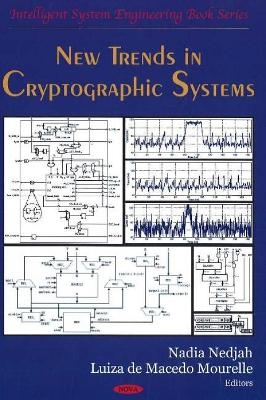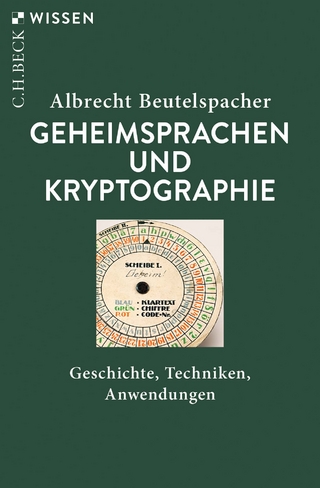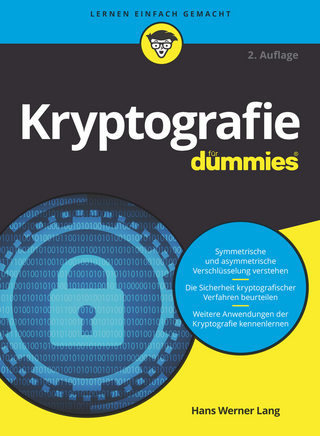
New Trends in Cryptographic Systems
Seiten
2006
Nova Science Publishers Inc (Verlag)
978-1-59454-977-9 (ISBN)
Nova Science Publishers Inc (Verlag)
978-1-59454-977-9 (ISBN)
Cryptography is the study of methods to transform information from its original comprehensible form into a scrambled incomprehensible form, such that its content can only be disclosed to some qualified persons. This book includes content that is focused on trends in cryptographic hardware, arithmetic and factoring.
Cryptography is the study of methods to transform information from its original comprehensible form into a scrambled incomprehensible form, such that its content can only be disclosed to some qualified persons. In the past, cryptography helped ensure secrecy in important communications, such as those of spies, military leaders, and diplomats. In recent decades, it has expanded in two main ways: firstly, it provides mechanisms for more than just keeping secrets through schemes like digital signatures, digital cash, etc; secondly, cryptography is used by almost all computer users as it is embedded into the infrastructure for computing and telecommunications. Cryptography ensures secure communications through confidentiality, integrity, authenticity and non-repudiation. Cryptography has evolved over the years from Julius Cesar's cipher, which simply shifts the letters of the words a fixed number of times, to the sophisticated RSA algorithm, which was invented by Ronald L. Rivest, Adi Shamir and Leonard M. Adleman, and the elegant AES cipher (Advanced Encryption Standard), which was invented by Joan Daemen and Vincent Rijmen. The need for fast but secure cryptographic systems is growing bigger. Therefore, dedicated hardware for cryptography is becoming a key issue for designers. With the spread of reconfigurable hardware such as FPGAs, embedded cryptographic hardware became cost-effective. Nevertheless, it is worthy to note that nowadays, even hardwired cryptographic algorithms are not safe. Attacks based on power consumption and electromagnetic Analysis, such as SPA, DPA and EMA have been successfully used to retrieve secret information stored in cryptographic devices. Besides performance in terms of area and throughput, designer of embedded cryptographic hardware must worry about the leakage of their implementations. The content of this book is divided into three main parts, which are focused on new trends in cryptographic hardware, arithmetic and factoring.
Cryptography is the study of methods to transform information from its original comprehensible form into a scrambled incomprehensible form, such that its content can only be disclosed to some qualified persons. In the past, cryptography helped ensure secrecy in important communications, such as those of spies, military leaders, and diplomats. In recent decades, it has expanded in two main ways: firstly, it provides mechanisms for more than just keeping secrets through schemes like digital signatures, digital cash, etc; secondly, cryptography is used by almost all computer users as it is embedded into the infrastructure for computing and telecommunications. Cryptography ensures secure communications through confidentiality, integrity, authenticity and non-repudiation. Cryptography has evolved over the years from Julius Cesar's cipher, which simply shifts the letters of the words a fixed number of times, to the sophisticated RSA algorithm, which was invented by Ronald L. Rivest, Adi Shamir and Leonard M. Adleman, and the elegant AES cipher (Advanced Encryption Standard), which was invented by Joan Daemen and Vincent Rijmen. The need for fast but secure cryptographic systems is growing bigger. Therefore, dedicated hardware for cryptography is becoming a key issue for designers. With the spread of reconfigurable hardware such as FPGAs, embedded cryptographic hardware became cost-effective. Nevertheless, it is worthy to note that nowadays, even hardwired cryptographic algorithms are not safe. Attacks based on power consumption and electromagnetic Analysis, such as SPA, DPA and EMA have been successfully used to retrieve secret information stored in cryptographic devices. Besides performance in terms of area and throughput, designer of embedded cryptographic hardware must worry about the leakage of their implementations. The content of this book is divided into three main parts, which are focused on new trends in cryptographic hardware, arithmetic and factoring.
A Dual Mode Public Key Co-Processor; Hardware Architectures for Modular Exponentiation Using M-Ary Methods; A Power Attack Methodology to AES Based on Induced Cache Misses: Procedure, Evaluation and Possible Countermeasures; Quadrinomial Modular Arithmetic using Modified Polynomial Basis; Applications of The Montgomery Exponent; Fast Radix-2 Montgomery Modular Multiplication Algorithm for RSA Implementations; Improvement of Inversion-Free Group Operations for Genus 3 Hyperelliptic; Curve Cryptosystems; Fault-Tolerance in Hardware for Sparse Systems of Linear Equations, with Applications to Integer Factorisation; Verifiable Threshold Sharing of a Large Secret Safe-Prime; Index.
| Erscheint lt. Verlag | 10.4.2006 |
|---|---|
| Zusatzinfo | Illustrations |
| Verlagsort | New York |
| Sprache | englisch |
| Maße | 260 x 180 mm |
| Gewicht | 488 g |
| Themenwelt | Informatik ► Theorie / Studium ► Kryptologie |
| Mathematik / Informatik ► Mathematik ► Angewandte Mathematik | |
| ISBN-10 | 1-59454-977-X / 159454977X |
| ISBN-13 | 978-1-59454-977-9 / 9781594549779 |
| Zustand | Neuware |
| Haben Sie eine Frage zum Produkt? |
Mehr entdecken
aus dem Bereich
aus dem Bereich
Geschichte, Techniken, Anwendungen
Buch | Softcover (2022)
C.H.Beck (Verlag)
9,95 €
Die faszinierende Geschichte der Verschlüsselung
Buch | Softcover (2022)
Springer (Verlag)
34,99 €


